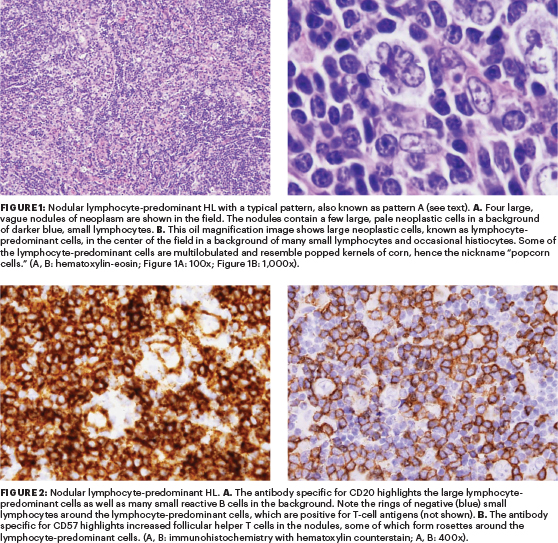Question 1
Which of the following statements about nodular lymphocyte-predominant HL is correct?
Correct answer: A. Nodular lymphocyte-predominant HL can transform into large B-cell lymphoma.
Expert Perspective
Nodular lymphocyte-predominant HL is a B-cell neoplasm characterized by a nodular or nodular and diffuse pattern. The neoplasm is composed of a proliferation of small lymphocytes, with scattered large neoplastic cells known as lymphocyte-predominant or “popcorn cells”1 (Figure 1). Although nodular lymphocyte-predominant HL can transform into diffuse large B-cell lymphoma or T-cell/histiocyte-rich large B-cell lymphoma, it does not transform into classical Hodgkin lymphoma. The nodular variant of lymphocyte-rich classical Hodgkin lymphoma can look similar, and immunophenotypic analysis is required to distinguish this neoplasm from nodular lymphocyte-predominant HL. Patients with nodular lymphocyte-predominant HL present with localized peripheral lymphadenopathy (stage I or II). Approximately 20% of patients present with advanced-stage disease. Mediastinal involvement is rare.
Question 2
In nodular lymphocyte-predominant HL, six distinct immunoarchitectural patterns are recognized. Which of the following statements about these patterns is correct?
Correct answer: D. All of the above.

Expert Perspective
A detailed description of growth patterns observed in nodular lymphocyte-predominant HL has been described by Fan et al.2 Six distinct immunoarchitectural patterns are recognized: Pattern A is the common B-cell–rich nodular; pattern B is nodular with interconnected nodules imparting a serpiginous appearance; pattern C is nodular with lymphocyte-predominant cells located at the periphery and outside of the tumor nodules; pattern D is T-cell–rich nodular; pattern E is like T-cell/histiocyte-rich large B-cell lymphoma; pattern F is diffuse B-cell–rich. In patterns A, B, C, and F of nodular lymphocyte-predominant HL, the architectural background is composed of variably large spherical meshworks of follicular dendritic cells. In pattern E, most of the neoplasm is diffuse, but small nodular areas must also be present. Often immunostaining using B-cell markers is required to detect the presence of nodules.1 The histopathologic variants C, D, E, and F are associated more often with advanced disease and a higher relapse rate compared with that of typical variants (A and B).1,3 Therefore, it is useful to note these variant features in the diagnostic report.
Question 3
Which statement about neoplastic lymphocyte-predominant HL is correct?
Correct answer: C. Lymphocyte-predominant cells are large and usually have a multilobulated nucleus.
Expert Perspective
The neoplastic lymphocyte-predominant cells are large and often have multilobulated nuclei and small, basophilic nucleoli, unlike the prominent nucleoli in classical Hodgkin/Reed-Sternberg cells.1 However, some lymphocyte-predominant cells may contain a prominent nucleolus and may be indistinguishable from classical Hodgkin/Reed-Sternberg cells on purely cytologic grounds. Lymphocyte-predominant cells are a minority of the cells in the neoplasm. Most cells are small reactive B cells and usually fewer T cells. Choice D is the immunophenotype of classical Hodgkin/Reed-Sternberg cells.1
Question 4
Which of the following lymphocyte-predominant cell immunophenotypes most likely represents nodular lymphocyte-predominant HL?
Correct answer: B. Strong co-expression of CD20, OCT2, and CD79a.
Expert Perspective
Lymphocyte-predominant cells are of B-cell lineage; they are positive for CD20, CD45, CD75, CD79a, OCT2, BOB1, and PAX5 in all cases. Lymphocyte-predominant cells are positive for BCL6, but CD10 is absent.4 Unlike the Hodgkin/Reed-Sternberg cells in classical HL, lymphocyte-predominant cells co-express OCT2, BOB 1, and activation-induced cytidine deaminase.5 In diffuse growth patterns of nodular lymphocyte-predominant HL, the presence of CD4+CD8+/CD57+/ PD1+ T cells favors this neoplasm (Figure 2A), whereas a total absence of small B cells, low numbers of CD57-positive T cells, and a dominant presence of CD8-positive cells and TIA1-positive cells favors T-cell/histiocyte-rich large B-cell lymphoma (Figure 2B).
DISCLOSURE: Dr. Abutalib is an advisor for AstraZeneca. Dr. Medeiros reported no conflicts of interest.
REFERENCES
1. Stein H, Swerdlow SH, Gascoyne RD, et al: Nodular lymphocyte predominant Hodgkin lymphoma, in Swerdlow SH, Campo E, Harris NL, et al (eds): WHO Classification of Tumours of Haematopoietic and Lymphoid Tissues, pp 431-434. Lyon, France, International Agency for Research in Cancer, 2017.
2. Fan Z, Natkunam Y, Bair E, et al: Characterization of variant patterns of nodular lymphocyte predominant Hodgkin lymphoma with immunohistologic and clinical correlation. Am J Surg Pathol 27:1346-1356, 2003.
3. Hartmann S, Eichenauer DA, Plütschow A, et al: The prognostic impact of variant histology in nodular lymphocyte-predominant Hodgkin lymphoma. Blood 122:4246-4252, quiz 4292, 2013.
4. Falini B, Bigerna B, Pasqualucci L, et al: Distinctive expression pattern of the BCL-6 protein in nodular lymphocyte predominance Hodgkin’s disease. Blood 87:465-471, 1996.
5. Mottok A, Hansmann ML, Braüninger A: Activation induced cytidine deaminase expression in lymphocyte predominant Hodgkin lymphoma. J Clin Pathol 58:1002-1004, 2005.

